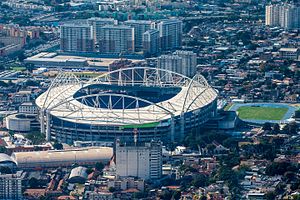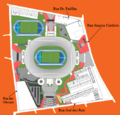Estádio Olímpico Nilton Santos
| Estádio Olímpico Nilton Santos | |
|---|---|
| Engenhão | |

|
|
| Aerial view of the stadium (May 2016) | |
| Earlier names | |
|
Estádio Olímpico João Havelange |
|
| Data | |
| place |
|
| Coordinates | 22 ° 53 '35.4 " S , 43 ° 17' 32.2" W |
| owner | City of Rio de Janeiro |
| operator | Botafogo FR |
| start of building | 2003 |
| opening | June 30, 2007 |
| First game | Botafogo FR - Fluminense Rio de Janeiro 2-1 |
| Renovations | 2013-2015 |
| surface | Natural grass |
| costs | R $ 380 million |
| architect | Carlos Porto |
| capacity | 46,931 places 60,000 places ( Olympics and Paralympics ) |
| playing area | 105 m × 68 m |
| Societies) | |
|
|
| Events | |
The Estádio Olímpico Nilton Santos ( German Olympiastadion Nilton Santos ) is a football stadium with an athletics facility in the Brazilian metropolis of Rio de Janeiro . It has been the home of the Botafogo FR football club since 2008 and was a venue for the Summer Olympics and Summer Paralympics in 2016 .
The stadium is also known as “Engenhão” , which goes back to the Engenho de Dentro district in which it is located. Since 2015 the home club Botafogo has also been allowed by the owner, the city of Rio de Janeiro, to name the stadium as Estádio Nílton Santos after the club's idol Nílton Santos . However, the controversial naming after the former Brazilian FIFA President João Havelange remained.
history
Construction of the stadium began in 2003 and was completed in 2007. According to estimates by the city administration, the stadium was to cost 60 million Brazilian reals (approx. 23 million euros) in 2003, and in the end the cost was 380 million real (approx. 146 million euros). On June 30, 2007, the stadium was opened with a game of the Brazilian soccer championship between Botafogo and Fluminense Rio de Janeiro (2-1) in front of 43,810 spectators. 40,000 cards were handed in for a milk powder donation.
In Brazilian terminology , Estádio Olímpico generally describes a stadium with a running track with an Olympic length (400 m). It was built on the occasion of the Pan American Games in 2007 and has 46,931 seats. It found here at the 2016 Olympic Games as well as in the upcoming Paralympics in 2016 , the Athletics -Competitions instead. For this purpose, the arena was expanded to 60,000 seats by extending the upper tiers in the stands behind the goals.
In front of the stadium is a statue of Nílton Santos , who played 729 games for Botafogo from 1948 to 1964 and made 75 appearances for the Brazilian national football team .
On August 3, 2007, Botafogo FR signed a 20-year lease for the stadium. The monthly rent is 36,000 real (14,000 euros) and the annual maintenance costs are 4 million real (1.5 million euros). On August 11, 2007, a 15 m long and 6 m high wall collapsed in the stadium, but nobody was injured. The first international match in the stadium took place on September 10, 2008 between Brazil and Bolivia . The World Cup qualifier ended 0-0.
With the renovation of the Estádio do Maracanã for the 2014 World Cup and the 2016 Olympic Games, the two clubs Flamengo and Fluminense played their games in Engenhão from 2010 to 2013 .
On July 14, 2012, it became known that the stadium would be renamed as a result of the corruption scandal involving João Havelange. Botafogo fans called for the stadium to be renamed. Former player Nílton Santos, whose statue stands in front of the stadium, and former coach João Saldanha were discussed as namesake . In August 2012, the 2016 Games Organizing Committee rejected the renaming.
In March 2013, the stadium had to be closed six years after it opened due to structural problems in the stadium construction. In June 2013, the city announced that the renovation work on the sports facility would take around 18 months. Engineers from the Pontifícia Universidade Católica do Rio de Janeiro discovered structural problems in the stadium roof in March. The structure had sunk, cracks formed in the steel and some parts were badly rusted from the salty sea air. Accordingly, the roof could have collapsed. On January 9, 2015, the Mayor of Rio Eduardo Paes announced that the Rio Stadium could be used again from February 1, 2015. Botafogo should in a game of Taça Guanabara on the Boavista Sport Club meeting. At first only the lower tier with 20,000 seats was opened. The reopening had to be postponed several times, the dates in October and December 2014 passed. The roof structure was re-fastened with 34 steel towers. After the work, the athletics facility, on which the heavy construction machinery stood, had to be completely rebuilt. For the Botafogo FR, the renovation phase was a big loss due to the lack of income from gaming operations and falling sponsorship funds. The club, which is already in debt, is missing about R $ 24 million (EUR 7.6 million) in the cash register.
Botafogo continues to strive for the stadium to be named after Nílton Santos.
After the 2016 Summer Olympics, the Botafogo FR has R $ 800,000 ( US $ 250,000 ), u. a. invested in replacing the stadium seats in order to transform the Olympic Stadium into a home stadium for the club. The neutral seats have been replaced by black and white seating. The measure was financed with personalized seats. For 50 R $ you could have your name printed on a seat. More than 8,000 fans took the opportunity, which covered half of the budget of the work.
On January 25, 2017 took place in the "Engenhão" a Chapecoense - charity match between Brazil and Colombia , in favor of the survivors of the crash of LaMia flight 2933 on 28 November 2016 instead. Only professionals working in South America were appointed to the game. The hosts won 1-0 with a goal by Dudu in the Olympic Stadium, which was not even half full with around 19,000 spectators.
gallery
The statue of Nílton Santos in front of the stadium (2009)
The athletics facility and training ground next to the Olympic Stadium (2008)
Panorama picture
Web links
- Stadium on Botafogo FR website , botafogo.com.br (Portuguese)
- Picture gallery , stadionwelt.de
- Data and pictures , stadiumdb.com (English)
- Olympic Stadium ( Memento from November 25, 2016 in the Internet Archive )
Individual evidence
- ↑ Prefeito permite, e Engenhão "vira" Estádio Olímpico João Havelange . In: Terra Brasil , February 10, 2015. Archived from the original on February 10, 2015. Retrieved on February 12, 2015.
- ^ Opening game Botafogo - Fluminense ( Memento of July 3, 2007 in the Internet Archive ), jbonline.terra.com.br (Portuguese).
- ↑ Stadium capacity , stadionwelt.de
- ^ Havelange Stadium before renaming , sport1.de of July 14, 2012
- ↑ Brazil: Shame on Havelange, fans demand stadium name change , stadiumdb.com of July 21, 2012 (English).
- ↑ Brazil: No name change for Estádio Havelange? stadiumdb.com from August 15, 2012 (English).
- ↑ Rio Olympics stadium closed due to roof problems , bbc.com of March 8, 2013 (English)
- ↑ Rio de Janeiro: 2016 Olympics stadium closed for 18 months , stadiumdb.com from June 8, 2013 (English)
- ↑ Rio de Janeiro: Engenhão reopening on Feb 1 , stadiumdb.com from January 12, 2014 (English)
- ↑ Brazil's Botafogo can't pay players after government freezes accounts , soccerly.com, August 7, 2014 (English).
- ↑ Botafogo pede à torcida que chame Engenhão pelo nome do nosso ídolo , botafogo.com.br of January 13, 2015 (Portuguese).
- ↑ stadiumdb.com: Rio de Janeiro: Botafogo reclaim Olympic Stadium in style article from January 24, 2017 (English).
- ↑ weltfussball.de: Brazil wins in the Chapecoense charity match Article from January 26, 2017.






